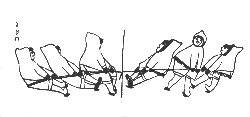
This copy of a stone cut titled Nushuraoto by the noted Inuit artist Pitseolak was created in 1968. The original print is in blue and white and measures 17" x 24.5". It depicts a "tugging" game as played in Cape Dorset, Baffin Island (eastern Arctic). It is typical of the Tug-o-War games played all over the world, and may not be indigenous to Inuit culture.
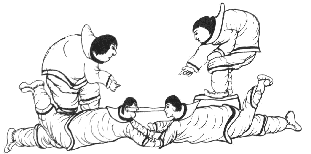
In contrast, the copy of the stone cut to the right is also from Cape Dorset, Baffin Island , and was created by Sorosilutoo and titled Nusutinguatut or Ear Tugging. (Government of Canada: Ministry of Indian & Northern Affairs, 1975, #QS-8050-000-BB-A1). This type of Tug-o-War game appears to be unique to Inuit culture.
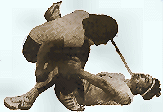
This photo of an Ear Tugging contest appears as part of a sequence in a National Film Board of Canada feature on Inuit games titled Northern Games, 1983. A length of soft leather is looped around each contestant's ear and as the stone cut illustrates, the players may start in the same position - but as the photo illustrates - by "pulling" or "tugging" - their positions change.

This additional photo (right) from the Public Archives of Canada illustrates another type of Inuit "Tugging" game, known as Ac Sa Raq . In this game, contestants start sitting on the ground facing one another, legs are straight, and feet are placed against the opponent's feet. The intent is to pull the opponent up off the ground.

The device which contestants use in this tugging game is pictured on the left. At times the device is made of wood or antler or walrus ivory connected by means of a short thong. The device in the photo called an Aksalak is from Igloolik, Baffin Island (E.H. Mitchell, Canadian Eskimo Artifacts, Ottawa: Canadian Arctic Producers, 1970).
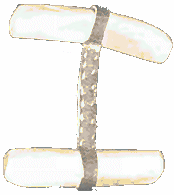
The photo at the right is an Aksalak in the Museum's Collection. It was made by Gyta Tirearnab in 1973 and purchased by the Museum from an Inuit Cooperative in the eastern Arctic.
The device is approximately 8cm long x 9cm wide, and is made of two pieces of carved bone, held together by a stiff piece of hide. The .8cm wide hide wraps around each bone in a groove, and is glued in place. There is a 5cm separation between the bones.
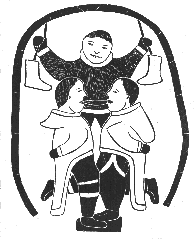 The 1972 illustration at the left is for a tugging game which uses an Aksalak like the one in the Museum's Collection. The stone cut is by Kalvak, a Holman Island artist, and is 18" x 24", printed in shades of brown.
The 1972 illustration at the left is for a tugging game which uses an Aksalak like the one in the Museum's Collection. The stone cut is by Kalvak, a Holman Island artist, and is 18" x 24", printed in shades of brown.
In this version of the game a man and a woman stand on one foot, hands behind their backs, and each holds one bone of the Aksalak between their teeth. The intent is to pull one's opponent until they fall against the other opponent. This version of the game is generally not considered a show of strenth - but in the spirt of a "courting game" or social activity.
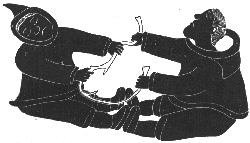
Another Holman Island tugging game is depicted in this copy (to the right) of a 1966 stone cut by Akourak. The print is in black measuring 23.5" x 19.5". Here the opponents in a sitting position, feet touching, hold an antler. Like in other "tugging" games, the intent is to pull an opponent across a designated line.
Last update June 20, 2010